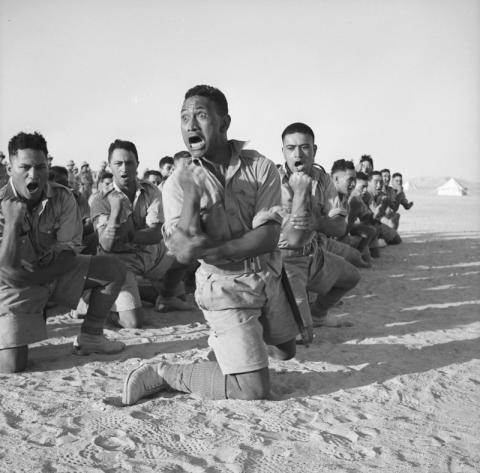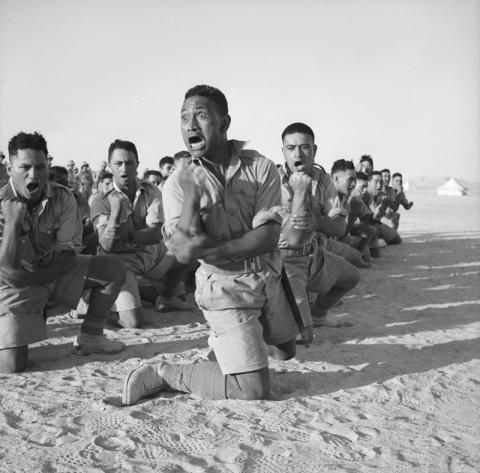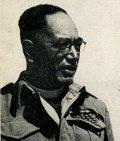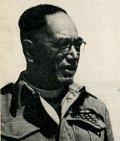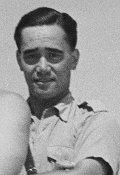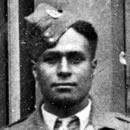<p>In the final item of the open air concert from El Diyura near El Alamein, Egypt on 23 September 1941, A Company sing <em>Koutou katoa rā, Me ata tukutuku</em> and <em>Pō ata rau</em>.</p>
<p>The items are introduced by an unknown speaker. Other speakers include Waaka Rewa, Alf Pitman, Maru Wharerau, Ben Porter and Maurice Robson.</p>
<p>[Site editors note: there is some static intermittently through the sound file] </p>
Media library
Audio
<p><strong>Sound file</strong> from Ngā Taonga Sound & Vision, ref: <a href="https://www.ngataonga.org.nz/collections/catalogue/catalogue-item?recor…;. Any re-use of this audio is a breach of copyright.</p>
<p>C Company performs this action song as part of the open air concert broadcast on September 23 1941. The Māori Battalion is at El Diyura near El Alamein, Egypt.</p>
<p>This is part five of the broadcast. <a href="/audio/a-company-sing-three-songs-egypt-1941">Listen to the final performance of the broadcast from A Company</a>. </p>
<p><strong>Sound file</strong> from Ngā Taonga Sound & Vision, ref: <a href="https://www.ngataonga.org.nz/collections/catalogue/catalogue-item?recor…;. Any re-use of this audio is a breach of copyright.</p><p><a href="http://natlib.govt.nz">Alexander Turnbull Library</a><br />Reference: DA-01229-F<br />Permission of the Alexander Turnbull Library, National Library of New Zealand, Te Puna Matauranga o Aotearoa, must be obtained before any re-use of this image.</p>
<p>On September 23, 1941the Māori Battalion is at El Diyura near El Alamein, Egypt. While there an open air concert was conducted and broadcast to the people back home. C Company performed two items including this haka.</p><p>This is part four of the broadcast. Listen to part five - <a href="/audio/c-company-action-song">C Company action song</a>.</p><p>[Site editors note: there is some static intermittently through the sound file]</p>
<h2>Transcript</h2>
<p>Ngati Porou, Toka-a-Taiau, Tarakeha, Tawhiti, Patangata, take o Hikurangi, me te ngutuawa o Waiapu, tena koutou katoa. Tenei a koutou tamariki te haka atu nei ki a koutou. </p>
<p><em>Kaea:</em> E, ko te
iwi Maori e ngunguru nei!<em><br />Katoa:</em> Au, au,
aue ha. Hi!<em><br />Kaea:</em> E, ko te
ope hoia e ngunguru nei!<em><br />Katoa:</em> Au, au,
aue ha. Hi!<em><br />Katoa:</em> Ahaha! Hitara koa! Kanga mai ra!<em><br />Katoa:</em> Taku upoko!<em><br />Kaea:</em> He tapu!<em><br />Katoa:</em> Taku
upoko!<em><br />Kaea: </em>No tuainuku!<em><br />Katoa:</em> Taku
upoko!<em><br />Kaea:</em> No
tuairangi!<em><br />Katoa: </em>Taku upoko!<em><br />Kaea: </em>Ahaha! <br />A, he koia, he koia, he koia ra. Hei kai mahau te whetu! Hei kai mahau te
marama! Piki tonu, heke tonu te Ika-ki-te-Reinga, i au! Au, au, au, hi! </p>
<p><em>Kaea: </em>A, i torona titaha! Haramai tonu ra nga ope hoia i runga i te
upoko hau, i te po marangai i te puehutanga mai o te kingi!<em><br />Katoa: </em>Ahaha! U whakarauiri ki Ihipa. Ka ki te whare ki te hoia uhia mai. Uhia mai to
kanohi ki te rau o te aroha.<em><br />Kaea: </em>Ahaha!<em><br />Katoa: </em>Aue, kia hiko au e! Te okaoka o taku
pu!<br />Kia hiko au
e! Te okaoka o taku pu!<br />Kei hinga
au e, kei mate au e.<br />Kei takoto
tonu, aue ha!<em><br />Kaea: </em>A, mate atu he toa!<em><br />Katoa: </em>Ara mai ra he toa!<em><br />Kaea:</em> Mate atu he toa!<em><br />Katoa:</em> Ara mai
ra he toa!<em><br />Kaea:</em> Tena
karawhiua!<em><br />Katoa:</em> Aue, aue,
aue! </p>
<p><em>Kaea:</em> A, ko komako, ko komako!<em><br />Katoa:</em> Ko te
hautapu e rite ki te kai na matariki. Tapareireia
koiatapa. Tapa konunua koiana tukua hi
aue hi!</p>
<p><em>Kaea:</em> Ka mate,
ka mate!<em><br />Katoa:</em> Ka ora ka
ora!<em><br />Kaea:</em> Ka mate,
ka mate!<em><br />Katoa: </em>Ka ora ka ora! Tenei te tangata puhuruhuru nana nei i
tiki mai whakawhiti te ra! <br />Upane, ka upane. Upane, ka upane, whiti te ra!</p>
<p><strong>Sound file</strong> from Ngā Taonga Sound & Vision, ref: <a href="https://www.ngataonga.org.nz/collections/catalogue/catalogue-item?recor…;. Any re-use of this audio is a breach of copyright.</p><p><a href="https://natlib.govt.nz">Alexander Turnbull Library</a><br />Reference: DA-01229-F<br />Permission of the Alexander Turnbull Library, National Library of New Zealand, Te Puna Matauranga o Aotearoa, must be obtained before any re-use of this image.</p>
<p>On September 23, 1941 the Māori Battalion is at El Diyura near El Alamein, Egypt. While there this open air concert was conducted and broadcast to the people back home.</p>
<p>New Zealand National Broadcasting Service announcer Noel Palmer introduces the programme and describes the environment. Private Tiaki (Jack) Tapiri sends greetings to the people at home and introduces the songs to be sung by B Company. The first <em>E te ope tuatahi</em>, was written by Sir Apirana Ngata as a recruiting song for the First Māori Contingent in World War One and then <em>Awhinatia mai matou</em>. </p>
<p>This is part one of the broadcast. </p>
<p>[Site editors note: there is some static intermittently through the sound file]</p>
<p><strong>Sound file</strong> from Ngā Taonga Sound & Vision, ref: <a href="https://www.ngataonga.org.nz/collections/catalogue/catalogue-item?recor…;. Any re-use of this audio is a breach of copyright.</p>
<p>Part three of the open air concert broadcast from El Diyura near El Alamein, Egypt on 23 September 1941. B Company sing two songs, <em>Moe mai e hine </em>and the <em>E pari rā</em>. </p>
<p>Listen to part four - <a href="/audio/c-company-haka">C Company peform a haka. <br /></a></p>
<p>[Site editors note: there is some static intermittently through the sound file]</p>
<p><strong>Sound file</strong> from Ngā Taonga Sound & Vision, ref: <a href="https://www.ngataonga.org.nz/collections/catalogue/catalogue-item?recor…;. Any re-use of this audio is a breach of copyright.</p>
<p>Sonny Waretini sings <em>He wawata </em>as part of an open air concert broadcast from El Diyura near El Alamein, Egypt on September 23, 1941. This is part two of the broadcast. Listen to part three - <a href="/audio/b-company-sing-two-songs-egypt-1941">B Company sing two songs</a>.</p>
<p><strong>Sound file</strong> from Ngā Taonga Sound & Vision, ref: <a href="https://www.ngataonga.org.nz/collections/catalogue/catalogue-item?recor…;. Any re-use of this audio is a breach of copyright.</p>
<p>September 23 1941, the Māori Battalion is at El Diyura near El Alamein, Egypt. While there an open air concert was conducted and broadcast to the people back home. </p>
<p>New Zealand National Broadcasting Service announcer Noel Palmer introduces the programme and describes the environment. Private Tiaki (Jack) Tapiri then sends greetings to the people at home and introduces the songs to be sung by B Company. The first <em>E te ope tuatahi</em>, was written by Sir Apirana Ngata as a recruiting song for the First Māori Contingent in World War One and then <em>Awhinatia mai mātou</em>. </p>
<p>This is part one of the broadcast. Listen to part two - <a href="/audio/private-sonny-waretini-sings-he-wawata">Sonny Waretini sings <em>He Wawata.</em> </a></p><p>[Site editors note: there is some static intermittently through the sound file] </p>
<p><strong>Sound file</strong> from Ngā Taonga Sound & Vision, ref: <a href="https://www.ngataonga.org.nz/collections/catalogue/catalogue-item?recor…;. Any re-use of this audio is a breach of copyright.</p>
<p>Padre Harawira continues with a final update on the activities of the Māori Battalion during December 1941. <br /><br />The officers of the Māori Battalion at this time are all young and except for the commanding officer, Colonel Dyer, are all Māori. The final days in battle before Christmas were difficult, with many casualties and a service was held for those who had been killed in the recent battles. On Christmas day the Battalion had a huge feast - a hangi with all kinds of Māori food sent from home, including Patriotic parcels. In early January Padre Harawira visited injured Māori Battalion soldiers in hospitals across Egypt. <br /><br />This recording is the final part of a broadcast made by the Māori Battalion about the Libyan campaign. It was primarily directed at the Battalions' people at home in New Zealand. </p><h2>Transcription</h2><p>[Macrons are not shown as users have the advantage of listening to the recording to see which vowels require emphasis.] <br /><br />Kua kite mai koutou e te iwi kua tamariki anake nga kaihautu i te waka nei. Kua Maori katoa hoki. Kotahi ano te Pakeha inaianei, ko te kanara. Me aha? He mokopuna na o ratou tipuna. Ka pu te ruha, ka hao te rangatahi. No tekau ma rima o nga ra, ka whakaekengia te paati noa uaua o te hoariri. No te po te tekau ma ono ka taea. No konei te hinganganui o te whanau. Engari no konei ano hoki te whatinga nui o te hoariri me te whakaotinga hoki o te mahi whakaritea ma nga Niu Tireni katoa. Tae rawa mai nga Poles ki te mau i ite pakanga, kore rawa i kitea kei hea te hoariri. No te tekau ma whitu o nga ra ka whakanga te whanau, ka huihui hoki. Tekau ma iwa o nga ra, ka whakahaeretia te karakia mo nga mea i hinga. No te rua tekau ma toru ka timata ta matou hoki mai. Kirihimete mai ki te rori. No te rua tekau ma iwa o nga ra o Tihema ka tutuki matou ki te wahi haere atu ai. I te ra o te Nuia katahi ano te hakari o te kirihimete; nga hangi poaka, tuna, kumara, titi, otira nga kai Māori katoa i tukua mai na e koutou. Ka tae katoa mai ano hoki nga pahara a te patriotic. E rua i te tangata kotahi. No te wha o nga ra o Hanuere ka haere mai matou ki konei. No te rima ka tae mai. No te whitu o nga ra ka haere ahau kia kite i nga mea i tu kei nga hohipera maha o Ihipa e takoto haere ana. Tata tonu ki te rau nga mea i kite au. Ka nui te ora. He mamao nga hohipera o etahi. Engari ka nui katoa te ora. Kei te whakawhaititia mai ratou inaianei ki nga hohipera o Nu Tireni. Tena koutou, tena koutou. E Api, tena koe. Paraire, kua panuitia o mihi. Pihopa o Aotearoa kua rongo atu matou i o mihi mai. Ma te Atua tatou katoa e manaaki, e tiaki, a koutou i kona, a matou hoki i konei, tena koutou.</p><h2>Translation</h2><p>People, you will be aware the officers of the Battalion are [now] only young men. They are also all Māori. There is only one European now, the colonel. They are the grandchildren of their ancestors. The old net is cast aside, the new net goes fishing. On 15 [December 1941] we ascended the enemy's stronghold. It was here we suffered heavy casualties. But it was also here that the enemy broke and the offensive by all the New Zealanders ended. The Poles (i.e. Polish) took over but could not find the enemy anywhere. On the 17th the Battalion rested and regrouped. The 19th we held a memorial service for our fallen comrades. On the 23rd we set out on our return journey [to Egypt]. Christmas was spent on the road. On 29th December we reached our destination. On New Years Day we got to have our Christmas meal; pork cooked in a hangi, eel, sweet potato, muttonbird, indeed all the food that you all have sent us. Also all the patrotic parcels have arrived. Two for each man. On 4th January we moved to were we are now. We arrived on the 5th. On the 7th I visited the wounded laid up in the many hospitals of Egypt. I saw close to one hundred. They are well. The hospitals that some are in are far away. But they are all doing well. They are now being transferred to the New Zealand hospitals. Greetings, greetings to all. O' Api, regards to you. Paraire, we have read your message of greeting. Bishop of Aotearoa we have heard you well-wishes. May God look after and protect us all, you over there [in New Zealand] and us here also, geetings.</p>
<p><strong>Sound file</strong> from Ngā Taonga Sound & Vision, ref: <a href="https://www.ngataonga.org.nz/collections/catalogue/catalogue-item?recor…;. Any re-use of this audio is a breach of copyright.</p><p>Image: M. L. Underhill et al., 1950, New Zealand Chaplains in the Second World War, War History, p.30 </p>
<p>Captain Frederick Tiwha Bennett commander of B Company gives an update of the activities of B Company. Along with other New Zealand and British forces they supported C Company in taking Point 152. They also supported A Company the following day at Point 154 when they had come under a counter-attack. <br /><br />Tiwha was the third son of the first Bishop of Aotearoa. His brother Charles Moihi Te Arawaka Bennett also served with the Māori Battalion and he later became its Commanding Officer. Read more about <a href="/memory/sons-bishop-captain-frederick-tiwha-bennett" target="_blank" title="Tiwha Bennett">Tiwha Bennett</a>. </p><p>This recording is part nine of a fuller broadcast made by the Māori Battalion about the Libyan campaign. </p>
<h2>Transcript (edited)<br /></h2><p>You have heard that Major Rangi Royal was wounded at Gazala together with his only remaining officer Mr Don Stewart. It was here that I was commanded to take over B Company. It was a big responsibility to undertake and we fully realised this when we went forward and began to organise what was remaining of the Arawas. The men were fit and eager to get into it again even though they had been fighting strenuously for some time. We had been allowed two subalterns by the CO to take over two of the three platoons, all of which had been without officers. One of the officers allowed me was Mr [Waipaina] Awarau of the Ngāti Porou and the other Mr [Ted] Pohio of Hawkes Bay. There was also the company Sergeant Major, Martin McRae, who through the whole campaign has proved himself a tireless and energetic warrior devoted to his men and devoted to his duties. For platoon sergeants there was Sergeant Les Hall, Sergeant Tommy Lawrence and Acting Sergeant Jack Tapiri. And so, there was an air of confidence that afternoon on the 17th of December when it was planned that Ngāti Porou C Company were to take a certain Point 152 and the Arawa B Company would support their attack on the left flank. Thus we went into action. Two great Māori tribes, fighting together, each with its own myths and fighting traditions behind it. For support we had New Zealand Vickers machine gunners in our ranks and in the rear New Zealand artillery and Royal Force Atillery. Tanks were there if required and also the planes of the RAF. But they were never called upon and before nightfall point 152 was no longer in enemy hands. <br /><br />That night we slept in enemy trenches and looking at the perfect construction the next morning and gazing at the mass of weapons, which the enemy had had at their disposal, we observed that had our boys been in the enemy positions nothing short of floods and famine would have shifted them from their seemingly impregnable position. Our casualties return for that day was nil. We looked forward to a nice long spell after that. But during the morning orders came that the Arawas were to move forward and support the left flank and the Ngapuhi A Company who were being threatened at Point 154 with a counter attack by a considerable enemy force. The boys responded unhesitatingly. Tired, dirty, hungry and war weary their response was magnificent when they were told the Ngapuhi were in danger. And ten minutes later we were moving towards them. At eleven o'clock we came under heavy fire but we moved forward and finally took our position on the right flank of the Ngapuhi. And that is where we stayed all day until dark. One wonders now, how any of us managed to get out alive as we were shelled by their big guns, their mortars and their machine guns all day long. But we hung on and as after events proved our support of the Ngapuhi was not in vein. We suffered casualties and so did A Company. But our reward came the next morning when we awoke and found the enemy had fled. And that was the start of a retreat that took him right back beyond Derna and Benghazi and which is still continuing. <br /><br />And so another great chapter is written. And all of you at home who are grieving over the deaths of your sons, and your husbands and your sweethearts take heart from the knowledge that their sacrifice is not in vein. The fight we are fighting is for freedom against servitude, right against might, good against evil. And it is only through your sacrifices that the things we love and cherish can ever survive. People in Ōhinemutu, Whakarewarewa, Maketū, Ōpotiki, Whakatane, Tauranga, Te Puke, all Arawas you have lost sons who died fighting fiercely for everything that is good and clean in life. </p>
<p><strong>Sound file</strong> from Ngā Taonga Sound & Vision, ref: <a href="https://www.ngataonga.org.nz/collections/catalogue/catalogue-item?recor…;. Any re-use of this audio is a breach of copyright.</p>
<p>Padre Kahi Harawira continues his description of the activities of the Māori Battalion in Libya during December 1941. As the Battalion advanced it was unsure of the location of the Germans until they began shelling. They kept driving forward on their vehicles somethingthe Italians had not seen beforer. The Italians were stunned and surrendered, moere than 600 of them. On the 12th the Battalion moved forward again onlt to come under fire again, <br /><br />The padre mentions that Major Royal has been injured and Captain Tiwha Bennett is now leading B Company with other officers' including his brother Captain Charles Bennett, Ruhi Pene, Eddie Morgan, Kuru Waaka and Meta Francis.</p>
<p>He then introduces Captain FT Bennett whose recording can be heard <a href="/audio/captain-tiwha-bennett-speaks-about-libyan-campaign" target="_blank" title="FT Bennett on the Libyan campaign">here</a>. </p><h2>Transcript <br /></h2><p>[Macrons are not shown as users have the advantage of listening to the recording to see which vowels require emphasis.] <br /><br />I a matou e haere nei, kore rawa e mohiotia pehea te mamao o te hoariri. Na te pakaru ra ano ko te mahi a te shell ki waenganui o matou taraka, katahi ano ka mohiotia na tata ano ia te hoariri. Otira kahore i taea te hoki ki muri. Engari ka kaha ke te haere o nga taraka ki roto i te mura o te ahi. He kokiri hou tenei, kahore ano tona rite i mua ano. No te tino piringa ano katahi ano ka pekepeke ki raro i nga taraka, takoto tapapa ai ki te whenua tatari ai ki te wa tika hei kokiritanga. Otira, kahore te hoariri tatari ki taua kokiri. Ka putaputa mai ki waho i o ratou rua, me o ratou ringaringa ki runga tu haere mai ai. Te ingoa o tenei wikitoria "he waimarie." E ono rau nuku atu ranei nga herehere i konei. Tekau ma rua o nga ra ka haere whakamua ano matou. Kahore i mamao te haeretanga atu, ka timata ano te puhia mai e nga pu nui o te hoariri. No konei ka mau mai te noho a te hoariri. Ka mohiotia atu koia nei to ratou pa uaua. Ka mauria ake nga pu nunui hei awhina i a matou. No tenei wa ka tu a Major Royal. Na reira ko Captain F.T. Bennett hei arahi i a Te Arawa. Koia nei nga apiha o B Company inaianei. Captain C. M. Bennett, Ruhi Pene, Eddie Morgan, Kuru Waaka, Meta Francis. Koia tenei ko Captain F.T. Bennett e korero atu nei ki a koutou.</p>
<h2>Translation </h2><p>As we proceeded along we did not know how far away the enemy was. When shells burst among our trucks only then did we realise the enemy were close at hand. Despite this we could not turn back. Instead we pressed on amidst the battle. This was a new style of attack, its like had not been seen before. When we were very close we jumped off and lay on the ground and waited for the appropriate time to attack. However, the enemy did not wait for that attack. They came out of their trenches with their hands raised as they approached. The name of this vistory was "good fortune." Six hundred or more were taken prisoners here. On the 12th we went forward again. We had not gone far when we were fired upon again by the enemy's big guns. Here the enemy held their positions. We knew this was their main fortress. We brought up our big guns to assist us. This is when Major Royal was wounded. Thus Captain F.T. Bennett took charge of B Company. These are B Companys' officers now: Captain C. M. Bennett, Ruhi Pene, Eddie Morgan, Kuru Waaka, Meta Francis. Here is Captain F.T. Bennett to speak to you.</p>
<p><strong>Sound file</strong> from Ngā Taonga Sound & Vision, ref: <a href="https://www.ngataonga.org.nz/collections/catalogue/catalogue-item?recor…;. Any re-use of this audio is a breach of copyright.</p><p>Image: M. L. Underhill et al., 1950, New Zealand Chaplains in the Second World War, War History, p.30</p>
<p>Captain Rangi Logan commander of D Company gives a brief update on their activities during the Libyan campaign. </p>
<p>In Menastir they fought alongside A Company and at Gazala they flanked the Polish. Capt. Logan comments on the loss of Jack Tainui who was in charge of one of the D Company platoons. </p>
<p>This recording is part six of a fuller broadcast made by the Māori Battalion about the Libyan campaign in 1941. </p>
<p>[Editors note - there is static throughout the sound file] </p>
<h2>Transcript</h2>
<p>I am honoured and deeply grateful for
the privilege afforded me of speaking to the men and relatives of the men of D
Company who fought under my command throughout the Libyan campaign. Their loyalty and staunch support is not born
of unity of blood or tribe, but of comradeship in arms. For one knows that men of D Company are drawn
from Waikato, Taranaki, King Country, Hawkes
Bay, Wairarapa, Wellington
and the South Island. When I took over command at Sollum it was the
morning of the assault upon the barracks.
We had suffered casualties like other companies but prepared for the
next task. My platoon commanders were Mr
Matehaere of Tirau, Mr Ormsby of Te Kuiti, and my great friend Sergeant Tainui
of the South Island. In the Battalion action at Menastir after
Sollum Mr Matehaere particularly distinguished himself by his fine leadership. While in command of our left flank. In this action together with the Ngapuhis on
our right, we annihilated German Battalions' for the loss of one man
killed. The actions of the company after
this can best be described in the actions of the battalion. At Gazala we had the pleasure of fighting
side by side with the Poles because attacking on the left flank of the
Battalion in broad daylight we were supported on our left by them. However, several of my men had the unenviable
experience of being mistaken for Italian troops and being taken prisoner by
them. In this same attack D Coy suffered
its greatest calamity, Jack Tainui one of the finest soldiers in our battalion
was killed. It was our last fight and if
he'd survived the attack for another ten minutes he would have been here now. However, such are the fortunes of war. I was proud of my men and you have every
reason to be proud of them. We are back
now and we have received reinforcements who will prove as good as those who
have gone. In officers too we are
reinforced. So my second in command is
Mr Ormond of Mahia, my platoon commanders are Mr Matehaere of Tirau, Mr Ropata
of Wellington and Mr Tikao-Barrett of Christchurch. With these officers and the men now in our
ranks I have every faith in the future. </p>
<p><strong>Sound file</strong> from Ngā Taonga Sound & Vision, ref: <a href="https://www.ngataonga.org.nz/collections/catalogue/catalogue-item?recor…;. Any re-use of this audio is a breach of copyright.</p>
<p><strong>Image reference:</strong><a href="https://natlib.govt.nz/"><br />Alexander Turnbull Library</a><br />Reference: DA-1371<br />Permission
of the Alexander Turnbull Library, National Library of New Zealand, Te
Puna Mātauranga o Aotearoa, must be obtained before any re-use of this
image. </p><p>The full photograph, from the
Alexander Turnbull Library, can be seen <a href="/photo/m%C4%81ori-battalion-swimming-team-1941" target="_blank">here</a>. </p>
<p>Captain Charles Bennett sends messages of condolences to Sir Apirana Ngata and the Ngāti Porou people. He pays special tribute to those who have fallen in the Second Lybian Campaign (November-December 1941), noting C Company's commander, Captain Parekura Tureia, and Lieutenant John Green. Padre Kahi Harawira follows with a further acknowledgement to those who have also fallen in battle. He mentions casualties which included the <acronym title="Commanding Officer">CO</acronym>, Lieutenant-Colonel Dittmer, who was replaced by Major Love. He notes that all the officers of the Battalion at that time are Māori. <br /><br />This recording in Māori is part five of a fuller broadcast made by the Māori Battalion about the Libyan campaign.</p><h2>Transcript</h2><p>[Macrons are not shown as users have the advantage of listening to the recording to see which vowels require emphasis.] </p><h2> </h2><p>Charles Bennett:<br />E Api, tena koe i a Ngati Porou. Hoatu te aroha me te tangi ki a Ngati Porou nui tonu. Kahore e taea te korero te toa me te manawanui o a koutou tamariki, mokopuna. Kore rawa i wehi, kore rawa i hoki whakamuri. Nga mea i hinga i hinga whakamua, te hinga rangatira, te hinga a o tatou tupuna. He aroha, nga tangi kei nga pouaru, kei nga pani. Haere e Pare, haere korua ko John Green me ta korua whanau. Kahore he aroha i nui atu i tena, kia tuku koutou i a koutou kia mate, mo te iwi, mo te ao. Haere ki te Atua. </p><p>Padre Kahi Harawira: <br />Kati ra, e penei ana te whakatauki a o tatou matua, a o tatou tipuna - i hinga atu ana he tetekura, e ara mai ana he tetekura. Kua takatu ano a Ngati Porou inaianei. Koianei o ratou apiha: ko Reta Keiha te pakeke i raro i a ia ko Te Hati Rangiuia, Waipaina Awarau me Walton Haig. Kua hoki ano a Charles Bennett ki tona iwi ki a Te Arawa. Ko Tuhiwai i noho tonu i waenganui i te Battalion i etahi o nga mahi. No taua kokiri ano ki Sollum ka tu to matou kanara a whakahokia ki te hohipera. Ka riro ko Major Love hei kaiarahi i te ope Maori. Ka Maori katoa ai nga apiha i tenei wa. </p><h2>Translation</h2><p>Charles Bennett:<br />O' Api, greetings to you and Ngāti Porou. Pass on our love and sympathies to the greater Ngāti Porou. We cannot say enough about the bravery and courage of your children and grandchildren. They never flinched, they never retreated. Those who fell [in battle] did so while they were advancing, a chiefly death, the death of our ancestors. Our compassion and empathy goes out to the widows and orphans. Farewell O' Pare, go thy way you and John Green and your men. There is no greater love than that, that you gave your lives for your people and for the world. Depart to the Lord.<br /> <br />Padre Kahi Harawira:<br />Well, there is a proverb of our parents and ancestors that goes like this - when one warrior falls, another warrior takes his place. Ngāti Porou (i.e. C Company) are ready again now (i.e. have had their numbers restored through reinforcements). These are their officers: Reta Keiha is in command and under him are Te Hati Rangiuia, Waipaina Awarau and Walton Haig. Charles Bennett has returned to his Te Arawa people (i.e. B Company). [Jim] Tuhiwai is still with the Battalion in another role. Also, during that attack on Sollum our colonel was wounded and taken back to hospital. Major [Tiwi] Love was given command of the Māori Battalion. At this time all the officers are Māori. </p>
<p><strong>Sound file</strong> from Ngā Taonga Sound & Vision, ref: <a href="https://www.ngataonga.org.nz/collections/catalogue/catalogue-item?recor…;. Any re-use of this audio is a breach of copyright.</p>
<p><strong>Image<br /></strong>Detail of <a href="/node/3910" target="_blank">Officers at Katerini</a><br /><a href="https://natlib.govt.nz/">Alexander Turnbull Library</a><br />Reference: DA-14231<br /> Permission of the Alexander Turnbull Library, National Library of New Zealand, Te Puna Mātauranga o Aotearoa, must be obtained before any re-use of this image.<strong><br /></strong></p><p> </p>


